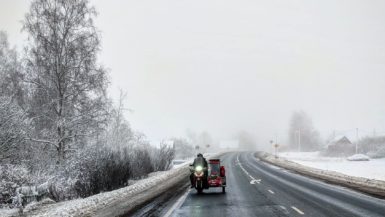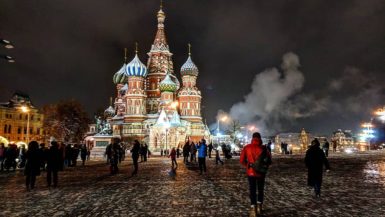Nicaragua was set to be the 26th country that we were to scoot through and when we were planning the trip was pretty low down on the list of countries that we thought could prove difficult. It sits in Central America which statistically speaking is one of the most dangerous places on the planet. Honduras and El Salvador regular fight it out for the unfortunate title of the murder capital of the world and it’s even more dangerous if you’re concerned with sticking up for the environment or speaking out against the human rights abuses committed by governments and multinational companies. We learnt all this way back at the start of planning this trip when we were chatting to Martin Mowforth of ENCA. Martin told us that we should plan well while going through some of the more dangerous regions but one place that wasn’t mentioned as a concern was Nicaragua.
Nicaragua borders both the Atlantic and the Pacific so if you want to head North from Panama to Alaska then you have to cross through. Until recently, Nicaragua was actually considered one of the safest places in the region and never did we imagine that it might end up in the position that it is now.
Currently, Nicaragua looks to be on the cusp of falling back in to a civil war. Pension reforms put forward by the President Daniel Ortega sparked large protests by students. These protests ultimately became violent and resulted in bullets being fired and many deaths. At the moment its estimated that around 100 people have been killed in the violence. As a result of the initial violence, the student protests turned from a peaceful demonstration against the reforms, to a full-on lock down of the country with the intention of ousting President Ortega and his wife (the Vice President).
This has meant that the protests branched out from Managua and now extend to all corners of the country. All major highways have road blocks that aim to stop the country functioning in order to pressure Ortega in to resigning. The situation in general is incredibly complex and both sides of the conflict have criticised the other of ‘fake news’ and using social media and news outlets to make the crimes or violence against them seem worse than it is. This means that it’s incredibly hard for anyone to get a real, genuine understand ing of the situation. This includes ENCA and their partner the Nicaragua Solidarity Campaign who have been working in the country for the last 30 years – one thing is for sure, if these guys can’t get to the bottom of the situation then we certainly can’t. We did a lot of research though and tried to work it out as best as we could. Here’s what we found out through chatting to ENCA, the NSC, other overlanders and people living in the country:
- There are definitely road blocks on every major highway that you could take to travel North through the country.
- These road blocks are manned by people armed with a mixture of weapons, including RPGs, machine guns and machetes.
- These road blocks are often built by digging up stretches of the road. Meaning that if you do manage to talk your way through you could find it difficult to actually drive through.
- The people manning the road blocks can be very friendly but can also be aggressive and confrontational.
- No side means any harm to tourists of any kind.
- Opportunist gangs have taken advantage of the unrest in order to commit crimes without repercussions.
- Overlanders on adventure bikes and in 4x4s have passed through with no issues.
This set of findings left us with a very hard decision to make. On the one hand, you don’t really want to run in to a guy with an RPG but on the other, if he means you no harm with it then there’s no real problem. Equally, every time we’ve been to anywhere a bit dodgy on this trip we’ve only been met with laughter at the sidecar and a warm welcome as a result. We also knew we could avoid Managua and likely avoid any opportunist gangs and keep to driving in the morning to avoid being more vulnerable on the lonely road at night. But the one problem we can’t get passed are the limits of the sidecar.
We’ve spoken to a number of overlanders who said they got through the country with no bother at all by talking their way through a road block, riding around/over/through the physical barriers or by taking off road trails to avoid them altogether. Firstly, we don’t speak Spanish so although smiling and pointing would probably work, it’s not ideal. Secondly, as we know from our trip across the Lagunas route, the outfit simply cannot handle much off-roading. In places like the Lagunas route this is just painful and funny because worst come to worse we can put the tent up and continue fixing or pushing the outfit in the morning. Whereas in Nicaragua it could leave us alone with a bunch of bored guys, armed with all sorts, at a road block, after dark which could put us back in to worrying about opportunist gangs who like the look of all of our cool kit. Equally, we regularly breakdown and have to seek the help of passers by and sometimes recovery vehicles. With the country as it is, recovery vehicles wouldn’t be a possibility and we’d never be able to order in the new clutch we’d almost certainly need after being forced to attempt and off-road trail.
So after talking through these concerns with ENCA and the guys at Survival Wisdom we decided that there was a fairly large risk of serious delays and large additional costs. This, combined with the unlikely but genuinely present safety risks, were enough to make us decide to miss Nicaragua.
Unfortunately, there are no easy options around Nicaragua by sea from Costa Rica or Panama either. This means that we’ve had to ship the bike North of Nicaragua. We’d hoped to ship it to Belize, Honduras or Guatemala but sadly the costs are astronomically higher than going to Mexico so we have been forced to put the bike in a container bound for Veracruz, Mexico. However, we are still hoping to see some of the organisations that ENCA work with in the Central American countries North of Nicaragua so we will most likely drive South from Veracruz and loop around back up to Mexico via Belize, Honduras and Guatemala.
It’s a shame to miss Panama, Costa Rica and Nicaragua but it just seems like a good idea this time. Hopefully, the situation changes in Nicaragua soon and there is some success with the current national dialouge.
If you’re trying to work out whether to drive through Nicaragua then the most valuable information is on the Pan American Travellers Association Facebook page.






Post on the board